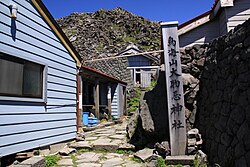Chōkaisan Ōmonoimi Shrine
Script error: No such module "Draft topics". Script error: No such module "AfC topic".
| Chōkaisan Ōmonoimi Shrine | |
|---|---|
 Altar of the shrine at the peak | |
Chōkaisan Ōmonoimi Shrine also known as Chokaisan Ōmonoimi-jinja is a Shinto shrine on Mount Chokai.[1][2][3][4] It worships Omonoimi no Kami,[5] Toyoukebime and Tsukuyomi-no-Mikoto.[6]
Every time the volcano erupted, the rank of Omonoimi no Kami was increased.[7] An eruption was interpreted as his angerr.[8]
It is a Beppyo shrine and a Myojin Taisha.[9]
It has been a prominent place of shugendo since the Middle Ages.[9][10]
A lake is worshipped there as a Kannabi.[11]
It is the Dewa Province Ichinomiya and linked with the Dewa Sanzan worship.[12]
It has a festival every year on July 14 called Hi-awase shinji. where fires are lit for good harvest and good fishing.[13]
It has three subshrines. Fukura-kuchinomiya and Warabioka-kuchinomiya at the foot of the mountain and Sancho-Gohonsha at the peak.[14]
It had a legal battle after World War II because people were confused about who owned the summit.[15]
Fukura-kuchinomiya[edit]
| Fukura-kuchinomiya | |
|---|---|
 Fukura-kuchinomiya | |
Fukura-kuchinomiya is a subshrine located at the foot of the mountain.[14]
The Honden is located on a hill and faces south.[6]
Tsukuyomi-no-Mikoto is enshrined here.
Sanchō-Gohonsha[edit]
| Sanchō-Gohonsha | |
|---|---|
 Sanchō-Gohonsha | |
This Shrine is on the peak of Mount Chokai.[14] It was built in 564 in the reign of Emperor Kinmei.[14] It looks like an ordinary cabin on the outside[16] The shrine is rebuilt once every 20 years, it was rebuilt in 1997.[9]
Warabioka-kuchinomiya[edit]
| Warabioka-kuchinomiya | |
|---|---|
 Warabioka-kuchinomiya | |
Warabioka-kuchinomiya is a subshrine located at the foot of the mountain.[14] The shrine worships agricultural deities Toyoke-Ookami and Ukanomitama no Mikoto.[6]
There is a festival on May 3rd called Daimonbei Matsuri.[9]
There are three torii gates and the movie Rurouni Kenshin: The Legend Ends was filmed there[17]
Omonoimi no kami[edit]

Omonoimi no Kami is the God of Chōkaisan Ōmonoimi Shrine and Mount Chokai.[18][19] There are shrines that enshrine Omonoiminokami in various other places in the Tohoku region, including Chōkai gassan ryōsho-gu.
Ōmonoimi-no-kami (大物忌神) is considered possibly identical to Toyouke-hime[lower-alpha 1][20]
He is associated with industrial growth.[21]
Every time Mount Chōkai erupted his rank increased.[22][19]
See also[edit]
- Chōkai gassan ryōsho-gu
- Gassan Shrine
- Rokusho Shrine
- Three Mountains of Dewa
- Ninomiya Kinowa Shrine
- Sannomiya Omoimi Shrine
simple:Chōkaisan Ōmonoimi Shrine
Notelist[edit]
- ↑ Ōmonoimi-no-kami is believed to be the god of Mount Chōkai in Yamagata prefecture, or the northernmost post of the land of Yamato.
References[edit]
- ↑ Fukada, Kyūya (2014-12-31). One Hundred Mountains of Japan. University of Hawaii Press. p. 76. ISBN 978-0-8248-4785-2. Search this book on

- ↑ Kōdansha (1983). Kodansha Encyclopedia of Japan. Kodansha. ISBN 978-0-87011-620-9. Search this book on

- ↑ "Climbing a less-crowded mountain in Japan". Stripes Okinawa. 2017-11-20. Retrieved 2023-10-26.
- ↑ Engi-shiki; Procedures of the Engi Era: Books I-V. Sophia University. 1970. Search this book on

- ↑ Fukada, Kyūya (2014-12-31). One Hundred Mountains of Japan. University of Hawaii Press. p. 76. ISBN 978-0-8248-4785-2. Search this book on

- ↑ 6.0 6.1 6.2 6.3 "Okunomichi". Archived from the original on 2014-10-14. Retrieved 2023-11-04. Unknown parameter
|url-status=ignored (help) - ↑ Fukada, Kyūya (2014-12-31). One Hundred Mountains of Japan. University of Hawaii Press. p. 76. ISBN 978-0-8248-4785-2. Search this book on

- ↑ Suzuki, Yui (2011-12-19). Medicine Master Buddha: The Iconic Worship of Yakushi in Heian Japan. BRILL. ISBN 978-90-04-22917-4. Search this book on

- ↑ 9.0 9.1 9.2 9.3 "chokaizan omonoimi shrine(warabioka kuchi no miya) - shrine-heritager". shrineheritager.com. Retrieved 2023-04-25.
- ↑ Castiglioni, Andrea; Rambelli, Fabio; Roth, Carina, eds. (2020). Defining Shugendō. Bloomsbury Academic. p. 57. doi:10.5040/9781350179424. ISBN 978-1-350-17939-4. Search this book on

- ↑ "Maruikesama" (PDF). Archived from the original (PDF) on 2022-05-02. Retrieved 2023-11-04. Unknown parameter
|url-status=ignored (help) - ↑ "Encyclopedia of Shinto詳細".
- ↑ https://archive.ph/wip/vFYys
- ↑ 14.0 14.1 14.2 14.3 14.4 "Chokaizan Omono-Imi Jinja - Must-See, Access, Hours & Price". GOOD LUCK TRIP. 6 June 2022. Retrieved 2023-04-25.
- ↑ "Reminiscences of Religion in Postwar Japan: Economic Changes after the War (Continued)". Contemporary Religions in Japan. 7 (1): 51–79. 1966. ISSN 0010-7557. JSTOR 30232985.
- ↑ https://archive.ph/NeCVF
- ↑ "Warabioka Kuchinomiya Shrine". Guidoor. Retrieved 2023-04-25.
- ↑ "chokaizan omonoimi shrine(warabioka kuchi no miya) - Shrine-heritager". shrineheritager.com. Retrieved 2023-10-17.
- ↑ 19.0 19.1 Fukada, Kyūya (2014-12-31). One Hundred Mountains of Japan. University of Hawaii Press. p. 76. ISBN 978-0-8248-4785-2. Search this book on

- ↑ Sonoda, Minoru; Mogi, Sakae (1997). Nihon no kamigami no jiten : Shinto saishi to yaoyorozu no kamigami. Books esoterica, 2.; New sight mook (in 日本語). Gakken. pp. 68, 69. ISBN 9784056016291. OCLC 42978057. Search this book on

- ↑ "Enshrined Gods". kawawajinja.com. Retrieved 2023-06-18.
- ↑ "Tallest Peak in North Japan: The Shugen History of Chokai-san". Tim Bunting. Retrieved 2023-05-10.
This article "Chōkaisan Ōmonoimi Shrine" is from Wikipedia. The list of its authors can be seen in its historical and/or the page Edithistory:Chōkaisan Ōmonoimi Shrine. Articles copied from Draft Namespace on Wikipedia could be seen on the Draft Namespace of Wikipedia and not main one.

|
This page exists already on Wikipedia. |
